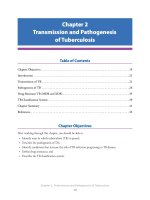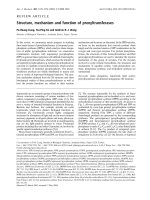Definition and Significance of Leadership docx
Bạn đang xem bản rút gọn của tài liệu. Xem và tải ngay bản đầy đủ của tài liệu tại đây (444.86 KB, 40 trang )
NGHỆ THUẬT LÃNH ĐẠO
MSMH: NS301DV01
Purpose
After studying this chapter, you will be able to:
•
Define leadership and leadership effectiveness
•
Explain why people need leadership
•
Discuss the major obstacles to effective
leadership
•
Compare and contrast leadership and
management
•
List the roles and functions of leaders and
managers
•
Summarize the debate over the role and impact
of leadership in organizations.
Content
Effective leadership
Obstacles to effective leadership
Leadership and management
Roles and functions of a leader
Changes in organizations and expectations of
leaders
Chapter 1:
Definition and
Significance of
Leadership
Chapter 1
1.1- Effective
Leadership
What is leadership?
•
Leadership is a group of phenomenon. There can be no
leaders without followers. As such, leadership always
involves interpersonal influence or persuasion.
• Leadership is goal directed and plays an active role in
groups and organizations. Leaders use influence to guide
others through a certain course of action or toward the
achievement of certain goals.
What is leadership?
•
The presence of leaders assume some forms of
hierarchy within a group.
–
Formal hierarchy, with leader at the top
–
Informal and flexible hierarchy.
Who is a leader?
•
A leader is a person who influences individuals
and groups within an organization, helps them in
establishing goals, and guide them toward
achievement of those goals, thereby allowing
them to be effective.
What is effectiveness?
•
Fred Friedler’s Contingency Model: Leadership
effectiveness = Performance.
–
Leaders are effective when their group perform well.
•
Robert House’s Path-Goals Theory: Leadership
effectiveness = Followers satisfaction.
–
Leaders are effective when their followers are satisfied.
• Transformational and Visional
Leadership Models: Effectiveness is
the successful implementation of
large scale change in an organization.
What is effectiveness?
•
Community point of view:
–
“Effectiveness is helping people communicate more,
collaborate more, and innovate more” (Mieszkowski,
1998)
–
“Cooperation, aligning people’ self-interest, and getting
buy-in from the people who are affected by the leader’s
decisions” (Baker, 2006)
–
“Helping the community, and bring self-sufficient”
(Salter, 2000a)
•
Sales point of view: Satisfied customer.
Effectiveness can only be achieved by providing
“attentive, sincere, memorable service”
(McGregor, 2004a: 83)
What is effectiveness?
1. The definitions of leadership effectiveness are as
diverse as the definitions of organizational
effectiveness. The choice of a certain definition
depends mostly
–
on the point of view of the person trying to determine
effectiveness, and
–
on the constituents who are being considered.
What is effectiveness?
2. Fred Luthans (1989): defines leadership
effectiveness by distinguishing between effective
and successful managers.
Effective Managers Successful Managers
Those with satisfied and productive
employees
Those who are promoted quickly
Spend their time communicating with
subordinates, managing conflicts, and
training, developing and motivating
employees
Focus not on employees. Instead, they
concentrate on networking activities
such as interacting with outsiders,
socializing and politicking.
What is effectiveness?
3. Any definition of leadership effectiveness should
consider all different roles and functions that a
leader performs.
–
In fact, organizations often fall back on simplistic
measures, regardless of how satisfied the company’s
employees are.
–
Stockholders and financials consider a CEO to be
effective if company stock prices keep increasing.
–
Politicians are effective if the polls indicate their
popularity is high and if they are reelected.
–
A football coach is effective when the team is winning.
– Students’ scores on standardized tests determine a
school principal’s effectiveness.
What is effectiveness?
•
The common thread in all these examples of
effectiveness is the focus on outcome.
–
To judge their effectiveness, we look at the results of
what leaders accomplish.
–
Process issues, such as employees’ satisfaction, are
important but are rarely the primary indicator of
effectiveness.
What is effectiveness?
The definition of leadership effectiveness, therefore,
should contain 3 elements:
• Goals achievement: meeting financial goals,
producing quality products or services,
addressing the needs of customers…
• Smooth internal process: group cohesion,
followers’ satisfaction, and efficient operations.
•
External adaptability: group’s ability to change
and evolve successfully
When is a leader effective?
•
Leaders are effective when their followers
achieve their goals, can function well together,
and can adapt to changing demands from
external forces.
Why do we need leaders?
• To keep group orderly and focused. The existence of groups
require some form of organization and hierarchy. Leaders are
needed to pull the individuals together, organize and coordinate
their efforts.
•
To accomplish tasks. Groups allow us to accomplish tasks
that individuals alone could not undertake or complete. Leaders
are needed to facilitate that accomplishment, to provide goals
and directions, and coordinate activities.
•
To make sense of the world. Groups and their leaders
provide individuals with a perceptual check. Leaders help us
make sense of the world, establish social reality, and assign
meaning to events and situations that may be ambiguous.
•
To be romantic ideals. Leadership is needed to fulfill our
desire for mythical or romantic figures who represent us and
symbolize our own and our culture’s ideals and
accomplishments.
Chapter 1
1.2- Obstacles to
Effective Leadership
Obstacles To Effective
Leadership
•
Organizations face considerable uncertainty that creates
pressure for quick responses and solutions.
– Implementing new methods of leadership would make dealing
with complexity and uncertainty easier in the long run.
– The lack of learning and experimentation causes the continuation
of the crises, which makes unavailable the time needed to learn
and practice innovative behaviors.
•
Organizations are often rigid and unforgiving.
–
In the push for short-term and immediate performance,
organizations do not allow any room for mistake and
experimentation. Such rigidity and reward systems discourage
endeavors.
Obstacles To Effective
Leadership
•
Organizations fall back on old ideas about effective
leadership, and therefore, rely on simplistic solutions
that do not fit new and complex problems.
• Organizations develop a particular culture that strongly
influences how things are done and what is considered
acceptable behavior.
– As leaders try to implement new ideas and experiment with new
methods, they may face resistance generated by the established
culture.
• The difficulty involved in understanding and applying the
findings of academic research.
Chapter 1
1.3- Leadership and
Management
Leadership and Management
Leadership and Management
Managers Leaders
Focus on the present
Maintain status quo and
stability
Implement policies and
procedures
Maintain existing structure
Remain aloof to maintain
objectivity
Use position power
Focus on the future
Create change
Initiate goals and strategies
Create a culture based on
shared values
Establish an emotional link
with followers
Use personal power
Chapter 1
1.4- Roles and
Functions of a Leader









